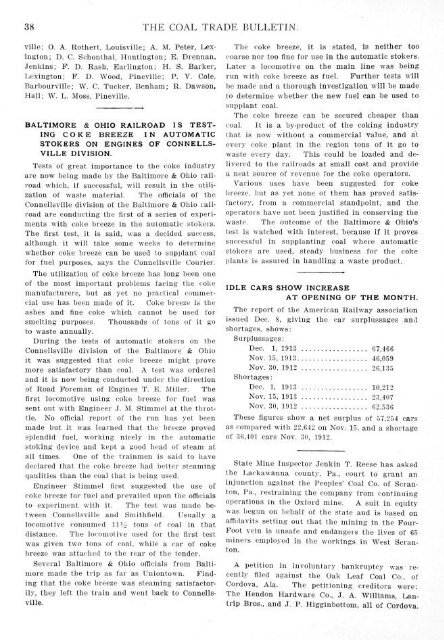coal trade bulletin - Clpdigital.org
coal trade bulletin - Clpdigital.org
coal trade bulletin - Clpdigital.org
Create successful ePaper yourself
Turn your PDF publications into a flip-book with our unique Google optimized e-Paper software.
38 THE COAL TRADE BULLETIN.<br />
ville; O. A. Rothert, Louisville; A. M. Peter, Lexington;<br />
D. C. Schonthal, Huntington; E. Drennan,<br />
Jenkins; F. D. Rash, Earlington; H. S. Barker,<br />
Lexington; F. D. Wood, Pineville; P. V. Cole,<br />
Barbourville; W. C. Tucker, Benham; R. Dawson,<br />
Hall; W. L. Moss, Pineville.<br />
BALTIMORE & OHIO RAILROAD IS TEST<br />
ING COKE BREEZE IN AUTOMATIC<br />
STOKERS ON ENGINES OF CONNELLS<br />
VILLE DIVISION.<br />
Tests of great importance to the coke industry<br />
are now being made by the Baltimore & Ohio railroad<br />
which, if successful, will result in the utilization<br />
of waste material. The officials of the<br />
Connellsville division of the Baltimore & Ohio railroad<br />
are conducting the first of a series of experiments<br />
with coke breeze in the automatic stokers.<br />
The first test, it is said, was a decided success,<br />
although it will take some weeks to determine<br />
whether coke breeze can be used to supplant <strong>coal</strong><br />
for fuel purposes, says the Connellsville Courier.<br />
The utilization of coke breeze has long been one<br />
of the most important problems facing the coke<br />
manufacturers, but as yet no practical commercial<br />
use has been made of it. Coke breeze is the<br />
ashes and fine coke which cannot be used for<br />
smelting purposes. Thousands of tons of it go<br />
to waste annually.<br />
During the tests of automatic stokers on the<br />
Connellsville division of the Baltimore & Ohio<br />
it was suggested that coke breeze might prove<br />
more satisfactory than <strong>coal</strong>. A test was ordered<br />
and it is now being conducted under the direction<br />
of Road Foreman of Engines T. E. Miller. The<br />
first locomotive using coke breeze for fuel was<br />
sent out with Engineer J. M. Stimmel at the throttle.<br />
No official report of the run has yet been<br />
made but it was learned that the breeze proved<br />
splendid fuel, working nicely in the automatic<br />
stoking device and kept a good head of steam at<br />
all times. One of the trainmen is said to have<br />
declared that the coke breeze had better steaming<br />
qaulities than the <strong>coal</strong> that is being used.<br />
Engineer Stimmel first suggested the use of<br />
coke breeze for fuel and prevailed upon the officials<br />
to experiment with it. The test was made between<br />
Connellsville and Smithfield. Usually a<br />
locomotive consumed 11% tons of <strong>coal</strong> in that<br />
distance. The locomotive used for the first test<br />
was given two tons of <strong>coal</strong>, while a car of coke<br />
breeze was attached to the rear of the tender.<br />
Several Baltimore & Ohio officials from Baltimore<br />
made the trip as far as Uniontown. Finding<br />
that the coke breeze was steaming satisfactorily,<br />
they left the train and went back to Connellsville.<br />
The coke breeze, it is stated, is neither too<br />
coarse nor too fine for use in the automatic stokers.<br />
Later a locomotive on the main line was being<br />
run with coke breeze as fuel. Further tests will<br />
be made and a thorough investigation will be made<br />
to determine whether the new fuel can be used to<br />
supplant <strong>coal</strong>.<br />
The coke breeze can be secured cheaper than<br />
<strong>coal</strong>. It is a by-product of the coking industry<br />
that is now without a commercial value, and at<br />
every coke plant in the region tons of it go to<br />
waste every day. This could be loaded and delivered<br />
to the railroads at small cost and provide<br />
a neat source of revenue for the coke operators.<br />
Various uses have been suggested for coke<br />
breeze, but as yet none of them has proved satisfactory,<br />
from a commercial standpoint, and the<br />
operators have not been justified in conserving tlie<br />
waste. The outcome of the Baltimore & Ohio's<br />
test is watched with interest, because if it proves<br />
successful in supplanting <strong>coal</strong> where automatic<br />
stokers are used, steady business for the coke<br />
plants is assured in handling a waste product.<br />
IDLE CARS SHOW INCREASE<br />
AT OPENING OF THE MONTH.<br />
The report of the American Railway association<br />
issued Dec. 8, giving the car surplussages and<br />
shortages, shows:<br />
Surplussages:<br />
Dec. 1, 1913 67,466<br />
Nov. 15, 1913 46,059<br />
Nov. 30, 1912 26,135<br />
Shortages:<br />
Dec. 1, 1913 10,212<br />
Nov. 15, 1913 23,407<br />
Nov. 30, 1912 62,536<br />
These figures show a net surplus of 57,254 cars<br />
as compared with 22,642 on Nov. 15, and a shortage<br />
of 36,401 cars Nov. 30, 1912.<br />
State Mine Inspector Jenkin T. Reese has asked<br />
the Lackawanna county, Pa., court to grant an<br />
injunction against the Peoples' Coal Co. of Scranton,<br />
Pa., restraining the company from continuing<br />
operations in the Oxlord mine. A suit in equity<br />
was begun on behalf of the state and is based on<br />
affidavits setting out that the mining in the Four-<br />
Foot vein is unsafe and endangers the lives of 65<br />
mineis employed in the workings in West Scranton.<br />
A petition in involuntary bankruptcy was recently<br />
filed against the Oak Leaf Coal Co.. of<br />
Cordova, Ala. The petitioning creditors were:<br />
The Hendon Hardware Co., J. A. Williams, Lantrip<br />
Bros., and J. P. Higginbottom, all of Cordova.

















